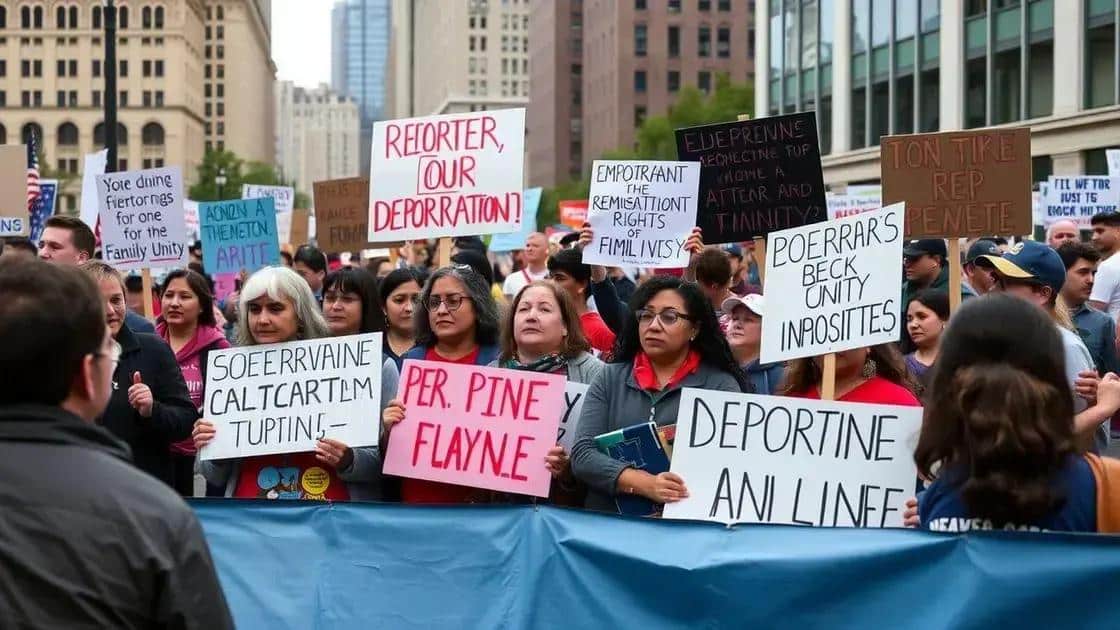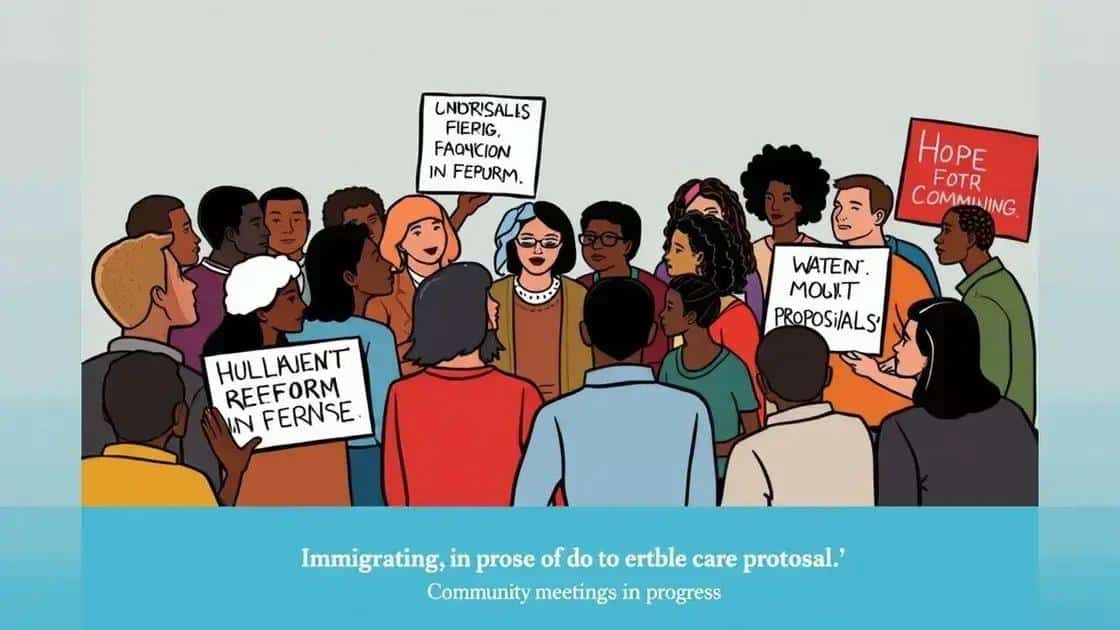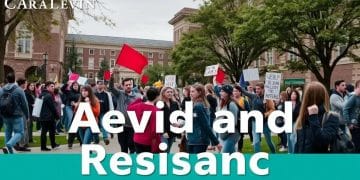Jon Stewart on Kilmar Abrego Garcia’s Deportation Insights
Anúncios
The future of immigration reform in America focuses on creating pathways to legal status for undocumented individuals, enhancing border security, and advocating for humane treatment, driven by shifting public opinion and grassroots movements.
Jon Stewart on Kilmar Abrego Garcia’s deportation sheds light on critical immigration issues facing America today. With the ongoing debates around deportation, it’s essential to explore how these policies affect real lives. Are we seeing justice served or overlooked narratives?
Background on Kilmar Abrego Garcia’s case
Understanding the background on Kilmar Abrego Garcia’s case is crucial to grasp the ongoing discussions around immigration policy. His story reflects the complex nature of deportation and the lives that are affected deeply by such decisions. Kilmar, originally from Mexico, found himself entangled in the unpredictable landscape of immigration enforcement.
As we dive into his case, we realize that it is not just an isolated incident. Many individual stories echo similar sentiments of fear and uncertainty. These narratives can often be overlooked but are essential for comprehending the broader context of immigration debates in America.
The Events Leading Up to Deportation
Before his deportation, Kilmar faced several challenges. His life in the United States was marked by:
- 🏘️ Building a stable community
- 💰 Contributing to local economies
- ⚖️ Facing legal barriers and challenges
The circumstances surrounding his case involved a series of misunderstandings and legal missteps that left him vulnerable. This is not an uncommon experience for many immigrants caught in the system who strive to secure their place in society.
Public Reaction and Media Coverage
The public reaction to Kilmar’s situation has been quite varied. Many advocate for immigration reform and support those like Kilmar who have been affected by strict policies. However, there are also voices that criticize the calls for reform, fearing what they see as a challenge to national security.
Media coverage has played a significant role in shaping perceptions. Reports often highlight personal stories, illuminating the human side of these policies:
- Interviews with family members
- Opinions from immigration advocates
- Statements from government officials
By understanding the impact stories like Kilmar’s have on communities, we can better appreciate the multifaceted discussions surrounding immigration policy.
Jon Stewart’s perspective on immigration issues

Exploring Jon Stewart’s perspective on immigration issues provides valuable insights into the complex and often contentious landscape of immigration in America. Stewart, known for his thought-provoking commentary, brings a unique lens to the topic that resonates with many viewers.
In his segments, he often emphasizes the human side of immigration policies. Instead of merely discussing statistics, he seeks to tell the stories of individuals affected by these decisions. This approach allows audiences to connect emotionally with the issues at hand, understanding the real-life implications of political actions.
Key Themes in Jon Stewart’s Commentary
Stewart frequently highlights several themes that reflect his stance on immigration:
- The importance of compassion in policy making
- Critiques of political rhetoric surrounding immigrants
- Calls for reform that prioritize human dignity
By focusing on these themes, he underscores the necessity of viewing immigrants as individuals rather than mere numbers or political pawns. His sharp wit often serves to dismantle the myths surrounding immigration, bringing clarity to complex issues.
Impact on Public Perception
Through his commentary, Stewart has influenced public perception around immigration policies. His ability to blend humor with serious topics encourages viewers to engage in discussions they might otherwise avoid. He highlights how negative portrayals of immigrants can lead to widespread fear and misunderstanding. By presenting a more balanced view, Stewart paves the way for a more informed dialogue among audiences.
As he challenges prevalent stereotypes, he encourages people to think critically about their beliefs and the narratives fed to them by media and politicians. Stewart’s perspective serves as a reminder that behind every policy, there are real people with real stories.
Trump’s policies on deportation: an analysis
The analysis of Trump’s policies on deportation reveals a significant shift in the approach to immigration enforcement in the United States. During his presidency, Trump implemented various strategies that aimed to tighten controls on undocumented immigrants.
One major focus of his administration was on increasing the number of deportations. This involved not only targeting individuals with criminal records but also those simply living in the country without authorization. Such policies created an environment of fear among immigrant communities.
Key Features of Trump’s Deportation Policies
Several key features stand out when discussing Trump’s deportation policies:
- 🚔 Expansion of ICE operations in communities
- 🛡️ Increased resources allocated to border security
- 📉 Reduction of protections for undocumented immigrants
These elements illustrate a clear intention to enforce immigration laws more strictly than in previous administrations. By empowering agencies like Immigration and Customs Enforcement (ICE), the Trump administration sought to create a perception of heightened security.
Consequences for Immigrant Communities
The impact of these policies has been profound. Families faced the threat of separation, while many sought to avoid interactions with law enforcement altogether. This environment contributed to a growing sense of anxiety and uncertainty.
Communities saw an increase in fear regarding reporting crimes or seeking help, knowing that any interaction with authorities could lead to deportation. Moreover, the policies sparked protests and rallies, as many citizens joined the call for humane treatment of immigrants.
The backlash against these policies also led to various legal challenges. Courts ruled on numerous occasions against the administration’s methods, signaling ongoing conflicts and discussions around immigration laws and human rights.
Public response to deportation stories

The public response to deportation stories varies widely, reflecting a range of opinions and emotions. These stories often resonate deeply within communities, prompting discussions about justice, humanity, and policy.
When deportation cases are highlighted in the media, they tend to elicit strong reactions from the public. Many people empathize with those facing deportation, recognizing the hardship and emotional turmoil involved. This empathy can lead to increased awareness and calls for change in immigration policy.
Protests and Advocacy
In response to deportation stories, numerous protests and advocacy efforts have emerged. Activists rally around the following key points:
- 🧑⚖️ Human rights protections for immigrants
- 👨👩👧 The importance of keeping families together
- 📢 Calls for more humane immigration policies
Such activism has brought attention to the challenges faced by immigrant communities. Many advocate for legislative reform that prioritizes compassion over punitive measures.
Influence of Social Media
The rise of social media has significantly shaped public responses. Platforms like Twitter and Facebook allow stories to spread quickly, engaging users in discussions about immigration issues.
Many users share personal stories or experiences, creating a more profound understanding of the impacts of deportation. Video footage, tweets, and posts can go viral, influencing public opinion rapidly and effectively. This online activism helps mobilize support and solidarity, encouraging more people to get involved.
While there are those who oppose immigration reform, the narratives shared on social media often highlight the positive contributions of immigrants to society. This contrasts sharply with common negative portrayals in some media outlets.
Impact of deportations on communities
The impact of deportations on communities is profound and often devastating. When individuals are deported, families are torn apart, leading to significant emotional and financial hardships.
Many families rely on each other for support. The loss of a breadwinner can jeopardize the financial stability of an entire household. Children may have to adjust to living without a parent, which can lead to psychological challenges and educational setbacks.
Social and Emotional Effects
Communities also feel the effects of deportation. The social fabric begins to fray as trust diminishes. People become hesitant to engage with local law enforcement, fearing that any interaction could lead to deportation.
This can create a sense of isolation among immigrant families. Many will avoid public places, such as schools and parks, out of fear of drawing attention to themselves. The mental health of these individuals can significantly decline due to the constant stress and anxiety related to potential separation from their loved ones.
Economic Consequences
Economically, deportations impact not only the families involved but the community as a whole. Businesses may suffer when employees are deported, leading to decreased productivity and financial losses.
- Reduced labor force in local markets
- Loss of consumers in communities
- Increased costs for social services
These economic shifts create further instability. Community cohesion is essential for a thriving economy, and when families are fragmented, the local economy can face severe challenges.
Moreover, the stigma surrounding deportation can deter newcomers from settling in a community, stifling growth and diversity. The long-term effects of these deportations resonate well beyond the immediate families affected, impacting the overall health and security of the community.
Future of immigration reform in America

The future of immigration reform in America remains a topic of intense debate and consideration. As the nation grapples with ongoing challenges related to immigration, there is a continuous push for changes that acknowledge the realities faced by immigrants.
Recent events have highlighted the need for a more compassionate and efficient immigration system. Advocates argue that the current system is outdated and inadequate to address the complexities of modern migration.
Key Areas for Reform
Future reforms may focus on several critical areas:
- Pathways to legal status for undocumented immigrants
- Enhancements to border security measures
- Streamlining the process for legal immigration
These changes aim to create a system that is fair and just, allowing individuals to contribute to society without fear of deportation. Supporting this reform is essential for building stronger communities and economies.
Political Landscape and Challenges
The political landscape surrounding immigration reform is complex. There are various opinions on how to best approach reform, with some advocating for stricter laws and others pushing for more lenient policies.
This division makes it challenging to achieve consensus on immigration reform. However, public opinion is shifting, as many Americans recognize the contributions of immigrants to the nation. This shift may lead to more support for reform initiatives in the future.
Moreover, grassroots movements are gaining momentum, mobilizing citizens to advocate for changes that promote justice and equality for all immigrants. These movements can significantly impact future legislation and public policy regarding immigration.
The future of immigration reform is a crucial topic that affects many lives. As we have seen, ongoing debates and discussions highlight the need for compassionate policies that address the realities faced by diverse communities. By focusing on key areas like pathways to legal status and humane treatment for all individuals, we can work together towards a more just system. The push for change is growing, backed by grassroots movements and shifting public opinion. As we navigate through these changes, it is essential to remain engaged and advocate for fair immigration laws that support family unity and community well-being.
FAQ – Frequently Asked Questions about Immigration Reform in America
What are the main areas of focus for future immigration reform?
Key areas include pathways to legal status for undocumented immigrants, enhancing border security, and streamlining legal immigration processes.
How can grassroots movements influence immigration reform?
Grassroots movements mobilize communities to advocate for fair policies and raise awareness about the contributions of immigrants.
What role does public opinion play in shaping immigration policies?
Shifting public opinion can foster support for more humane immigration laws, encouraging lawmakers to pursue necessary reforms.
Why is community engagement important in the reform process?
Community engagement helps build support for immigrants, creating a united front that drives positive changes in immigration policies.






